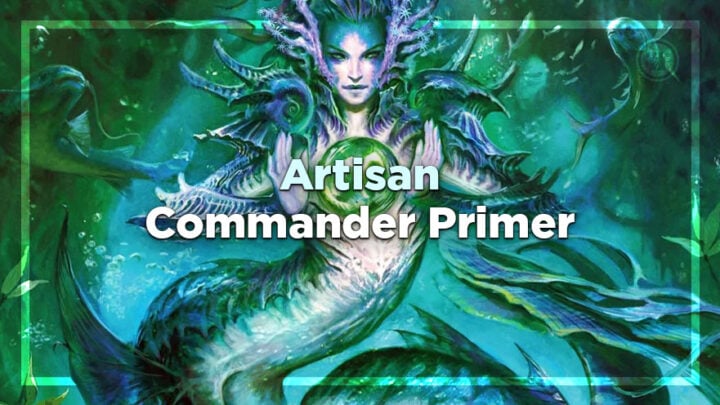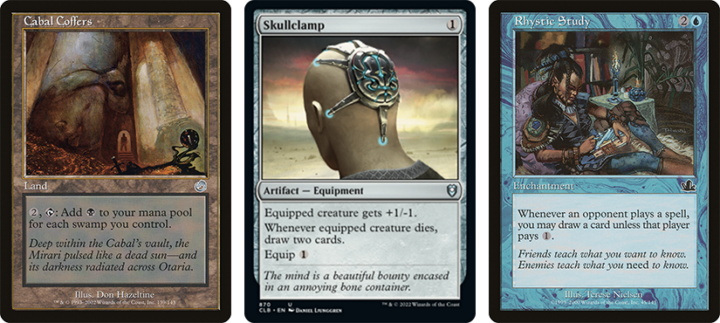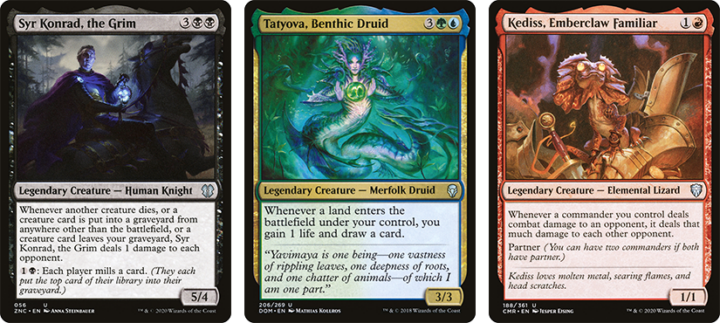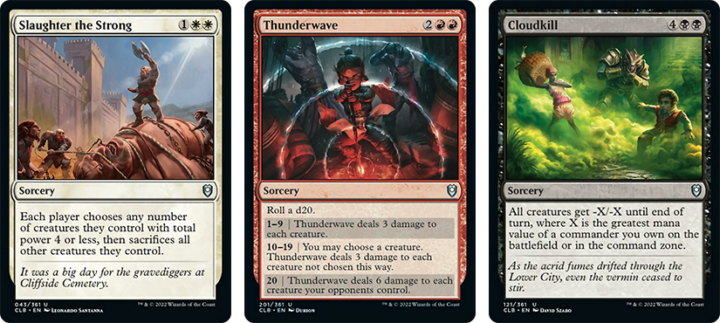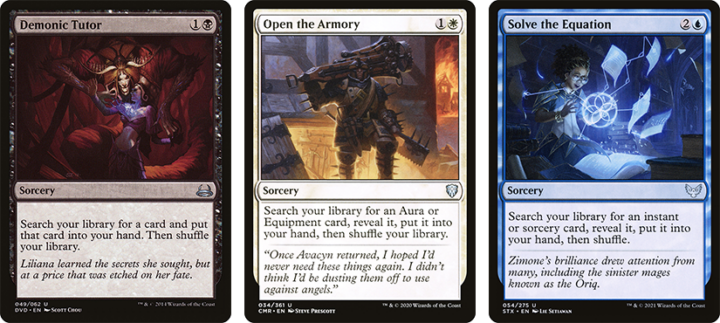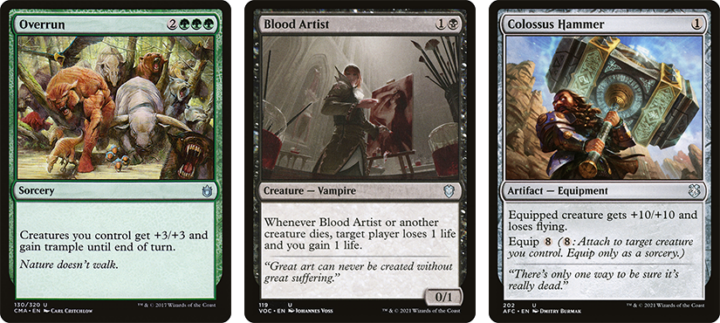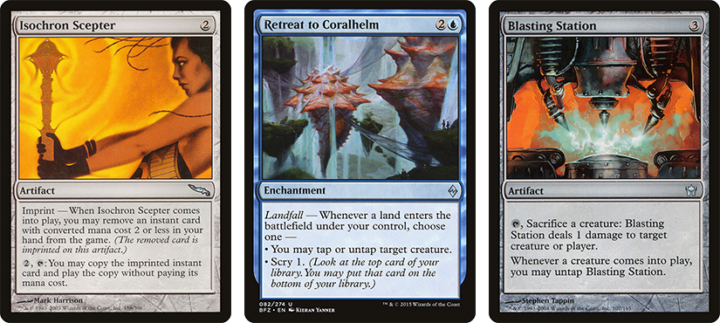Scott gives us an overview of the Artisan Commander format, Commander variant that cuts out all Rare and Mythic cards.
Power level talks and rule zero discussions have been a hot button topic in the Commander community recently. Everyone wants to have a good game, and to have some agency in how that game plays out. I previously wrote a piece on how to make this more likely through codifying power levels; in it I mentioned Artisan Commander as an already codified power level. It’s one of the lesser-known ways to play, but it has been gaining a lot of traction as more players try it out!
This is a brief introduction to Artisan Commander. I’ll cover the basics, like the typical commanders and staples, the differences between it and regular Commander, and highlight why this might be the kind of game for you.
What is Artisan Commander?
Artisan Commander is an offshoot of Commander that retains the same rules and ban list, but with one big difference: there are no rares or mythics allowed. Any card that was ever printed at common or uncommon, either in paper or on Magic Online, is legal. Commanders must still be legendary creatures, you still start at forty life, and commander damage is still there.
The format (or codified power level) was conceptualized in October 2021 by Alex Kessler, and it has been steadily growing in popularity since.
Much like Pauper, most players that are yet to try it don’t fully understand the kind of power that’s possible at lower rarities. Did you know that Cabal Coffers, Skullclamp, and Rhystic Study were all printed at common or uncommon once? These are all legal in Artisan Commander!
Why Artisan Commander?
There are a number of reasons to try Artisan Commander. First of all, it’s a completely different play experience to Commander as a whole. The card pool is very different, and many of the cards you’re used to seeing aren’t legal. There’s no Dockside Extortionist, no Smothering Tithe, no Cyclonic Rift. You also won’t find Atraxa, Praetor’s Voice or Prosper, Tome-Bound here either; every aspect of the landscape is completely different to Commander, and that alone makes it worth exploring.
It’s also much cheaper on average than Commander. While Commander decks can easily cost hundreds of dollars, it’s rare to see an Artisan Commander deck over $100, sometimes even $50! This makes for an easy entry level to Commander in general, plus it’s a great way to afford several decks without breaking the bank. All Artisan Commander decks are Commander legal too, so you can still use them to great effect in lower or mid power games too!
Since board wipes tend to be rare, there are significantly fewer to be found here compared to Commander. This means that overextending is less of a worry, and committing to the board is one of the main ways to win games. In addition to a lack of board wipes, there are fewer explosive cards, since they tend to reside at higher rarities. This translates to more grindy games overall, since no one’s usually equipped to have a scary or fast start.
If you don’t like some of the “feel bad” strategies in Commander, then Artisan may be a safe haven for you. Cards like extra turn spells and stax pieces are almost exclusively rare or mythic, so these aren’t present in the format. If you like good, clean, fair Magic, then this might just be the place for you.
Since it’s relatively new and has a mostly niche following, it means Artisan Commander is still largely unexplored. This makes it a brewer’s paradise; it’s the perfect place for players to try out new commanders and strategies, and to see what new spice lies in wait of discovery. Since the power level tends to be quite flat across the format, it also means that lower power commanders might actually gain a relative power bump, since they likely don’t lose much compared to their Commander counterparts.
Artisan Commanders
As any commanders that were only printed at rare or mythic aren’t legal here, you’re not going to see most of the usual suspects here. There are still a plethora of different commanders however (216 at the time of writing), with some excellent options for all sorts of strategies.
Syr Konrad, the Grim and Tatyova, Benthic Druid are examples of two very different yet exceptionally popular commanders that are legal in Artisan, and are still incredibly powerful with a card pool of lower rarities. Several commanders with Partner joined the format with Commander Legends, like Kediss, Emberclaw Familiar, and now Battle for Baldur’s Gate sees commanders with Backgrounds join the ranks as well. Your choices are expanding massively with every set release, further diversifying an already very divergent format.
Artisan Commander also just recently received a huge boon: three color commanders. The uncommon cycle of commanders from Streets of New Capenna gave the format five new options for players that want to play with multiple colors; before that, there was only Ragnar, Bartel Runeaxe, and Lady Evangela! [All of which were printed at Uncommon in Masters Edition III, an MTGO-only set – ED] Much like the rest of the format, these are still new and exciting, and there’s still plenty of room to brew with them.
Staples
As I explained earlier, some powerful staples still exist in Artisan Commander, like Skullclamp. But many Commander staples aren’t present here: there’s no Chaos Warp, no Solemn Simulacrum, and no Austere Command. This means the cards that you’ll see regularly will be somewhat different to the ones in Commander. I’ll cover a few of the cards that you’d expect to see in the format here:
Interaction
There’s no shortage of powerful interaction in any color here, as most of the best removal spells were printed at common or uncommon. Swords to Plowshares, Beast Within, Vandalblast, and Reclamation Sage are all still fantastic cards in Artisan Commander. Even counterspells are in abundance here, like Counterspell, Arcane Denial, and even Mana Drain if you’re feeling spiky!
Board Wipes
As I mentioned earlier, board wipes are much more rare (pun intended) in Artisan Commander. Some of the best options available are Slaughter the Strong, Thunderwave, and Cloudkill. After that, you’re looking at small sweepers like Pyroclasm or Flaying Tendrils. While they’re not perfect, they tend to mop up a lot of problems, and they’ll still be decent card advantage.
Ramp
Ramp is almost completely unchanged. The usual suspects are still here, like Sol Ring, Arcane Signet, and the various Signets and Talismans, as well as mana dorks and land ramp, like Cultivate and Fyndhorn Elves. This might seem like green still has a huge advantage over the other colors for mana acceleration, but since there are fewer powerful large threats and spells to take advantage of this, it tends to regulate itself well enough.
Tutors
If you want to add some consistency to your Artisan Commander deck, there are a plethora of tutors at your disposal. You can go for hyper efficient options like Demonic Tutor, Worldly Tutor, and Mystical Tutor, or you can go for some more relaxed choices like Open the Armory or Solve the Equation. There are plenty of strong and playable cards in the format, so you’ll still be spoiled for choice even if you eschew tutors altogether.
Win Conditions
When you want to win the game, you can pick your poison. You may not have access to Craterhoof Behemoth, but Overrun is still a phenomenal card all these years later; it’s often more than enough to alpha strike players through massive board stalls, as evidenced by countless players playing it in Commander still. Sacrifice decks have many powerful options to close out games, since most Blood Artist effects were printed at uncommon. If you want to win with commander damage, you also have access to absurdly powerful equipment, like Colossus Hammer.
Combos
Combos aren’t necessary to winning games, but they can help slower or creature-light decks to go over the top of the table. You have many options, but I’ll cover a few of the more well-known ones. Dramatic Reversal and Isochron Scepter combo is legal here, as is Retreat to Coralhelm with Walking Atlas and Simic Growth Chamber. These are fairly common in Commander already, and will feel at home in more powerful Artisan Commander decks. Another favorite of mine is Blasting Station with Renata, Called to the Hunt and a Persist creature, like Lesser Masticore. This would be an excellent addition to green-black decks, like Kagha, Shadow Archdruid.
What Does an Artisan Commander Deck Look Like?
Even with all of this information, it can be hard to visualize what a fully formed Artisan Commander deck might look like. I’ll show you my two current decks, to help give you an idea.
- Esior, Wardwing Familiar x Ardenn, Intrepid Archaeologist (Artifact Voltron)
- Syr Carah, the Bold (Burn Storm)
You might notice that they look quite similar to their regular Commander counterparts. They generally follow the same design principles, and feature a lot of the same cards. They still feel like Commander decks too, so piloting an Artisan deck should generally feel no different to any other.
Artisan Commander Resources
If the idea of Artisan Commander has piqued your interest, there are a lot of resources already available to help you get into the format. The Discord server is full of Artisan Commander fanatics who are more than happy to help you with any format or brewing questions, and there are an increasing number of YouTube videos featuring excellent Artisan Commander gameplay. Alex Kessler also has an Artisan Commander primer episode of The MM Cast, as well as other episodes dedicated to Artisan set reviews. I also did an Artisan Primer and Battle for Baldur’s Gate episode on The BM Cast, if you’re looking for additional listening.
I hope this has helped explain this wonderful Commander variant, and maybe even spark some inspiration for your first Artisan deck. If you want to talk more about the format, you can find me on Twitter, or I might see you in the Artisan Commander Discord!

Scott is an Irish content creator and the Head of Budget Magic for the Izzet League. He focuses on affordable decks in Pioneer, Modern, and Pauper, particularly ones that stray from the mainstream. When he’s not writing about his favorite decks, he can be found talking incessantly about them on Twitter and on The Budget Magic Cast.

